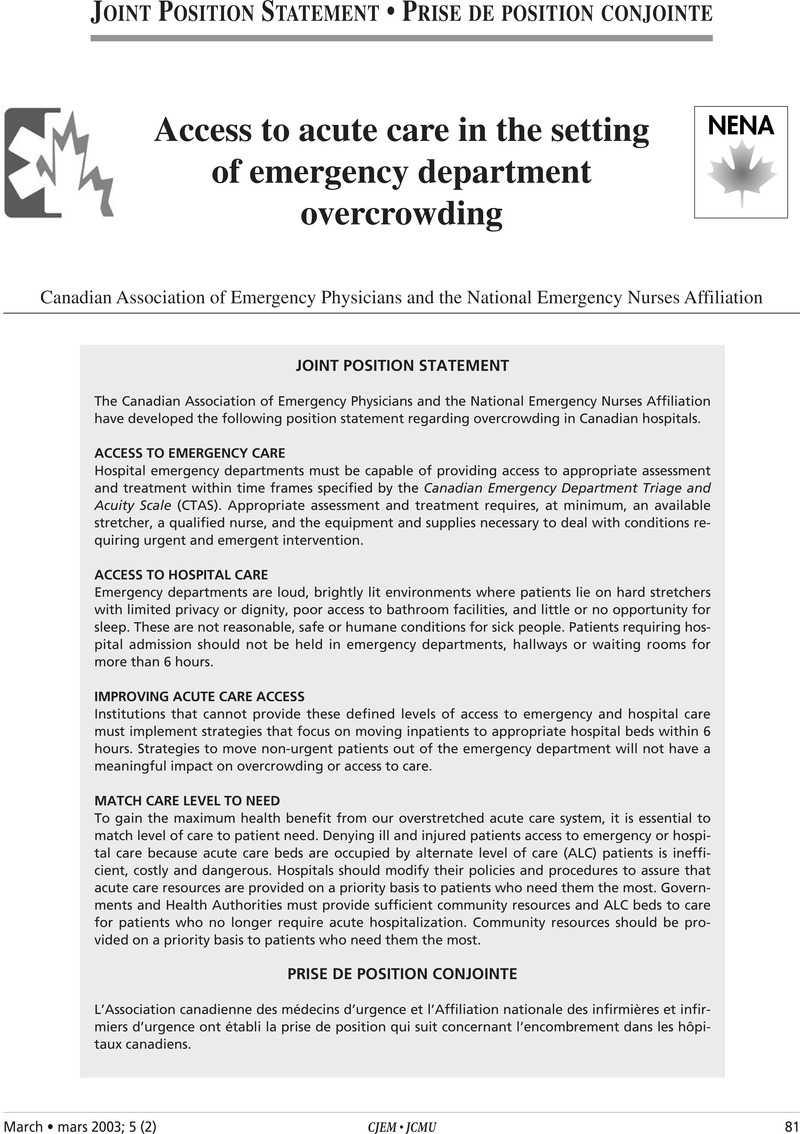Crossref Citations
This article has been cited by the following publications. This list is generated based on data provided by Crossref.
Noseworthy, Susan B.
2004.
Emergency department overcrowding: Waiting for disaster.
Canadian Journal of Emergency Nursing,
Vol. 27,
Issue. 1,
p.
12.
Schull, Michael J.
Mamdani, Muhammad M.
and
Fang, Jiming
2004.
Community influenza outbreaks and emergency department ambulance diversion.
Annals of Emergency Medicine,
Vol. 44,
Issue. 1,
p.
61.
Holroyd, Brian R
Rowe, Brian H
and
Sinclair, Douglas
2004.
Current political issues facing emergency medicine in Canada.
Emergency Medicine,
Vol. 16,
Issue. 3,
p.
190.
Symons, Peter
and
Shuster, Michael
2004.
International EMS Systems: Canada.
Resuscitation,
Vol. 63,
Issue. 2,
p.
119.
Vertesi, Les
2004.
Does the Canadian Emergency Department Triage and Acuity Scale identify non-urgent patients who can be triaged away from the emergency department?.
CJEM,
Vol. 6,
Issue. 05,
p.
337.
Richardson, Sandra K.
Ardagh, Michael
and
Gee, Paul
2005.
Emergency department overcrowding: the Emergency Department Cardiac Analogy Model (EDCAM).
Accident and Emergency Nursing,
Vol. 13,
Issue. 1,
p.
18.
Bradley, Victoria M.
2005.
Placing Emergency Department Crowding on the Decision Agenda.
Journal of Emergency Nursing,
Vol. 31,
Issue. 3,
p.
247.
Darrab, Ayad Al
Fan, Jerome
Fernandes, Christopher M.B.
Zimmerman, Rosanne
Smith, Rhonda
Worster, Andrew
Smith, Teresa
and
O??Connor, Kelly
2006.
How does fast track affect quality of care in the emergency department?.
European Journal of Emergency Medicine,
Vol. 13,
Issue. 1,
p.
32.
Field, Simon
and
Lantz, Andrea
2006.
Emergency department use by CTAS Levels IV and V patients.
CJEM,
Vol. 8,
Issue. 05,
p.
317.
Holroyd, Brian R.
Bullard, Michael J.
Latoszek, Karen
Gordon, Debbie
Allen, Sheri
Tam, Siulin
Blitz, Sandra
Yoon, Philip
and
Rowe, Brian H.
2007.
Impact of a Triage Liaison Physician on Emergency Department Overcrowding and Throughput: A Randomized Controlled Trial.
Academic Emergency Medicine,
Vol. 14,
Issue. 8,
p.
702.
Koran, Zeb
2007.
The Impact of an Admission Unit on Failure- and Late-to-Rescue Rates in the Emergency Department.
Advanced Emergency Nursing Journal,
Vol. 29,
Issue. 4,
p.
339.
Falvo, Thomas
Grove, Lance
Stachura, Ruth
Vega, David
Stike, Rose
Schlenker, Melissa
and
Zirkin, William
2007.
The Opportunity Loss of Boarding Admitted Patients in the Emergency Department.
Academic Emergency Medicine,
Vol. 14,
Issue. 4,
p.
332.
Ospina, Maria B.
Bond, Kenneth
Schull, Michael
Innes, Grant
Blitz, Sandra
and
Rowe, Brian H.
2007.
Key indicators of overcrowding in Canadian emergency departments: a Delphi study.
CJEM,
Vol. 9,
Issue. 05,
p.
339.
Whyne, Mitchell
Whyne, Garrett
and
Rowe, Brian H.
2007.
Variations in monetary distribution among Ontario’s Alternative Funding Agreement workload model hospitals.
CJEM,
Vol. 9,
Issue. 01,
p.
21.
Sinclair, Douglas
2007.
Emergency department overcrowding – implications for paediatric emergency medicine.
Paediatrics & Child Health,
Vol. 12,
Issue. 6,
p.
491.
Holroyd, Brian R.
Bullard, Michael J.
Latoszek, Karen
Gordon, Debbie
Allen, Sheri
Tam, Siulin
Blitz, Sandra
Yoon, Philip
and
Rowe, Brian H.
2007.
Impact of a Triage Liaison Physician on Emergency Department Overcrowding and Throughput: A Randomized Controlled Trial.
Academic Emergency Medicine,
Vol. 14,
Issue. 8,
p.
702.
Steele, Sandra
Anstett, Danielle
and
Milne, W. Ken
2008.
Rural emergency department use by CTAS IV and V patients.
CJEM,
Vol. 10,
Issue. 03,
p.
209.
Woods, Robert A.
Lee, Renee
Ospina, Maria B.
Blitz, Sandra
Lari, Harris
Bullard, Michael J.
and
Rowe, Brian H.
2008.
Consultation outcomes in the emergency department: exploring rates and complexity.
CJEM,
Vol. 10,
Issue. 01,
p.
25.
Mutrie, David
Bailey, S. Kathleen
and
Malik, Saleem
2009.
Individual emergency physician admission rates: predictably unpredictable.
CJEM,
Vol. 11,
Issue. 02,
p.
149.
Lowthian, Judy A
and
Cameron, Peter A
2009.
Emergency demand access block and patient safety: A call for national leadership.
Emergency Medicine Australasia,
Vol. 21,
Issue. 6,
p.
435.



